Although 1867 was not a particularly historical year, it did mark the conclusion of almost thirty years of Queen Victoria’s [1819-1901] sixty-four-year reign. It also gave rise to a number of significant British sporting clubs, including the oldest Scottish Association Football Club Queen’s Park FC, and the Sheffield Wednesday FC which also came into being, when it was inaugurated at the Adelphi Hotel in Sheffield. It was initially an offshoot of The Wednesday Cricket Club and went by the name of The Wednesday Football Club until it changed to its present title in 1929. In common with all rugby union clubs at the time, the Wasps Football Club kicked off as an amateur team. Now known as the Wasps Rugby Football Club it was based in Middlesex, West London until 2014 when it relocated to the 32,000 seat Ricoh Arena in Coventry.
However, arguably the most remarkable sporting creation of that specific year was the foundation of the oldest miniature golf course which still in existence, the St. Andrews Ladies’ Putting Club. Founded as a ladies only member’s club, it was required to closely observe the masculine self-indulgent customs of the day, declaring it undignified and conspicuously unladylike to raise a golf club past shoulder height.
Around 1860, caddies from the St. Andrews course laid out a small putting area, close to where the Rusacks Hotel now stands, just a flick with a sand-wedge from the world-famous 18th hole of the Old Course. There they would pass the time of day polishing up their putting skills while waiting for a golfer to engage their services.
At the time croquet, battledore and archery were just some of the sporting pastimes in which respectable young women might actively engage. But when the caddies’ course was quiet, a few of the more adventurous young ladies would venture out and play, which resulted in significant friction developing between the caddies and the spirited ladies. So much so that a piece of ground to the north of the Swilcan Burn was put aside, where the ladies could indulge in a little demure putting, as long as they remained ladylike and didn’t make too much noise. The ground was rough and pitted with rabbit holes and was used by local washer-women to dry their clothes. Nonetheless, a nine-hole miniature links was laid out by the St. Andrews keeper of the green and professional, Old Tom Morris [1821-1908], and the vilified ladies were presented with their own little piece of St Andrews upon which the St Andrews Ladies’ Golf Club was formed.
The first competition took place there in 1867, when the winner was presented with a prize of a gold locket and the runner-up a silver pebble brooch. These prizes still remain in the Club’s possession and are played for to this day in an annual competition.
Three decades passed before a basic corrugated iron shelter was built in 1898, which served as a clubhouse until it blew down a century later in 1999, when the present clubhouse was built.
As the Club continued to flourish the number of its members swelled significantly, and by 1900 there were four hundred lady members, and two hundred gentlemen who were granted Associate Membership status.

The Himalayas
Now better known as The Himalayas, the course can now be found a short walk from the town centre, between the famous Old Course and the West Sands course, where a challenging eighteen hole mini-golf course is housed, along with a neat little nine hole course on which young enthusiasts are encouraged to play. There may not be any windmills or loop-the-loop obstacles on the course, but to this day it remains one of the most prestigious miniature golf courses in the world.
It goes without saying that at some time or another, almost anyone taking a leisurely stroll along the promenade at Bognor or Bournemouth, Skegness or Southport, will have been suckered into forking out a couple of quid, to pick up a battered brass-necked putter and a well-worn golf ball, and try their luck at mini-golf. It matters not one jot that they may have never before picked up a golf club during the course of their entire life. Designed to be employed left or right-handed according to preference, the putter is the only implement required to complete the seemingly simple task which lies ahead.
Mini-golf, or crazy golf, emerged during the early part of the 20th century, when it concentrated solely on the putting characteristics of its next of kin. And much as we might like to lay claim to the game first starting in the United Kingdom, the truth is it is a transatlantic prodigy which dates back to the American mini-golf boom of the 1920s. Played on courses using synthetic putting surfaces, frequently incorporating a number of artificial obstacles, the aim of the game is to score the least number of strokes over a number of holes of relatively short length.
The earliest documented record of an attempt to package mini-golf was patented in 1907 by a British Army Colonel, William Senhouse Clarke [1848-1937]. A report on a game named Gofstacle was included in the 8 June 1912 edition of The Illustrated London News, where the game was described as consisting of a wooden box containing a number of painted metal obstacles, hoops, balls, putters and a peg, which presumably the player had to attempt to hit with the ball.
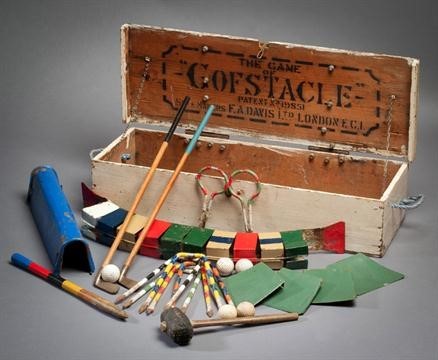
Gofstacle
The first miniature golf course to enter the commercial market was designed and built a few years later in 1916 by James Barber, the owner of the Barber Steamship Lines, in the grounds of his home in Pinehurst, North Carolina. The course was compact and featured fountains, gardens, and pleasant pathways. It is said that upon seeing the finished course for the first time Barber pronounced, ‘This’ll do’, which was modified to the name which ultimately caught on, ‘Thistle Dhu’.
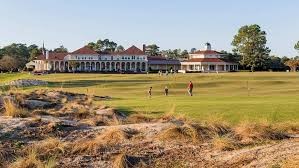
Thistle Dhu, Pinehurst
In 1927 the legendary golfer Walter Hagen [1892-1969] alleged that the finest miniature golf course in America was Thistle Dhu. Widely considered one of the world’s finest golfers, Hagen was a major figure in the sport during the first half of the 20 century. Notching up a tally of 11 professional major championship wins, including the US Open twice, and in 1922 he became the first American to win the British Open.
Golf fanatic Thomas McCullough Fairbairn is acknowledged as having revolutionised mini-golf from the earlier version provided by Thistle Dhu to its more modern form. In 1922 Fairbairn introduced artificial greens and bunkers, and added curves and water hazards to course layouts. Modifications which are said to have led to the game becoming more widely accessible, and the resultant boom in miniature golf. A team tournament for the Fairburn Cup is still held every summer at the miniature golf course Pirate Island on the Seven Mile Island in New Jersey.
- Pirate Island, New Jersey
- Roof-top Mini-golf, New York City
By the late 1920s the American public got their chance to play high-rise mini-golf, when the game’s popularity among New York City office workers led to over 150 rooftop courses opening up on top of the cloud covered skyscrapers. Gradually leading to the spread of tens of thousands more rooftop courses spreading across the United States of America.
However, the American mini-golf explosion of the early 20 century came to an end ten years later during the economic depression of the late 1930s. Miniature golf became too expensive for many people to afford, and nearly all the mini-golf courses in the USA were closed and demolished before the end of the decade. In turn this led to the emergence of ‘crazy golf’ courses, which incorporated obstacles scrounged from whatever materials found lying around, including tyres, rain-guttering, barrels, and pipe-work. Crazy golf courses became so popular they grew to become a regular feature across the USA.
The American inventor and entrepreneur John Garnet Carter [1883-1954] is today considered one of the founding fathers of mini-golf. In 1927 Carter was the first to patent a version of the game called ‘Tom Thumb Golf’. Built on the popularity of the crazy golf courses, Tom Thumb courses featured inventive hazards, built by workers in his ‘fantasy factory’.
Carter built a Tom Thumb miniature golf course on Lookout Mountain where he owned a hotel, and within a few years, thousands of Tom Thumb courses had opened all over the United States. By the early 1930s it is estimated around a quarter of miniature golf courses in the USA were Tom Thumb patented designs, and by the end of the era some four million people were playing miniature golf. Carter eventually sold the rights to his patent, and used his fortune to found the tourist attraction on Lookout Mountain known as Rock City Gardens.
The earliest documented mini-golf competition to take place in the USA was held in 1930, when the first National Tom Thumb Open Mini-golf Tournament was played. Offering a total purse of $10,000, and a winner’s prize of $2,000, qualification took place in each of the 48 states. The final attracted more than 200 competitors from 30 states, and was held at the mountain ridge location of Lookout Mountain in Chattanooga, Tennessee, where in 1863 the Union military defeated Confederate forces in the Battle of Lookout Mountain during the American Civil War.
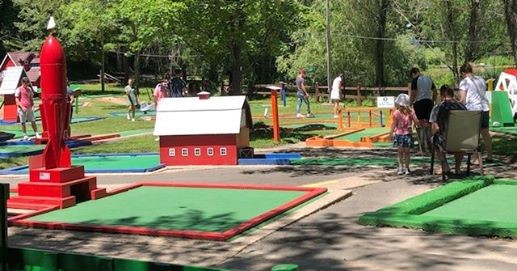
Tom Thumb Golf
A rare surviving example from the period when the sport was enjoying huge popularity is the Parkside Whispering Pines Miniature Golf Course, which can be found in the picturesque hamlet of Sea Breeze, Monroe County, New York. Once known as Tall Maples Miniature Golf Course, it was built in 1930 and in 2002 was listed under its former name in the National Register of Historic Places, the official list of historic places worthy of preservation.

Parkside Whispering Pines
Born in Binghampton, in the county seat of, Broome County, New York, two brothers, Joseph and Robert Taylor [1917-2008], picked up the ball and ran with it in 1938, when they began building and operating their own brand of miniature golf courses. In the early 1940s they formed Taylor Brothers, building and supplying mini-golf courses that differed from the ones of the late 20s and early 30s. Their designs no longer just incorporated rolls, banks, and curves, with an occasional pipe thrown in. The brother’s courses featured landscaping, and obstacles such as miniature windmills, castles, and wishing wells. And during both the Korean and Vietnam wars of the 1950s, many a G.I. Joe enjoyed mini-golf as a means of entertainment on a Taylor made prefabricated course, commissioned and shipped overseas by the US Military.
But in 1953 another mini-golf revolution was initiated by Don Clayton, the founder of Putt-Putt Golf and Games. At the age of 28 Clayton, was advised to take a break from selling insurance in his hometown of Fayetteville, North Carolina, and was soon out playing miniature golf. Before long he became so exasperated with what he considered badly designed courses, and disillusioned with the type of shots featured in the Tom Thumb style tracks, he became an advocate for miniature golf as a serious sport, and set about creating his own interpretation of the game, designing courses with only straight putts, devoid of any trick hazards.
Founded in 1954, Putt-Putt Golf, now Putt-Putt LLC, was soon exporting its ‘par two’ mini-golf courses to, Argentina, Australia, Brazil, India, Iran, Italy, Japan, Korea, Pakistan, South Africa, and several of the Eastern Bloc countries. Now many such family entertainment centres are branded as Putt-Putt Fun Centres. When he died in a Fayetteville hospital at the age of 70, the brainstorm he had in 1954 had grown into an international franchise with over a $100 million turnover.
However, Clayton’s vision didn’t last long, for in 1955 Lomma Golf Inc. was founded by Al and Ralph Lomma. The brothers revived the development of animated mechanical hazards, which demanded accurately aimed shots and split-second timing in order to avoid the spinning blades of miniaturised windmills, and other forms of obstacles
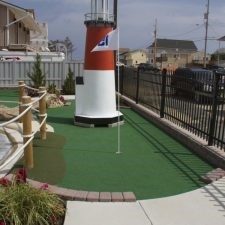
In a vain attempt to bring together and organise the various miniature golf operators in order to better promote the game, the first US Miniature Golf Association was inaugurated in 1961, Known as the National Association of Putting Course Operators, Manufacturers [NAPCOMS] the organisation only lasted a few years before it disbanded. Its legacy being the National Miniature Golf Day, which was launched in 2007, and is now held annually in the USA in mid-May.
Miniature golf also made a brief reappearance in Manhattan in 1989, when Donald Trump, at one of his smaller construction projects, built a mini-golf course in Central Park, in which the obstacles were appropriately tower blocks!
Near neighbours Canada was just a couple of decades behind the USA in opening its first miniature golf course. It was built at the infamous Maples Inn in Pointe-Claire, Quebec. Formerly known as the Lakeside Hotel it was originally constructed in 1895 as a three-storey boarding house. Renovated and converted into a gentlemen’s club in 1902, it eventually opened to the public in 1914, and was at the cutting edge of the development of miniature golf when it opened its course in 1930. But in common with the USA, the economic depression of the 1930s eventually led to its demise.
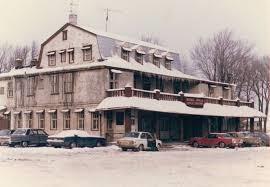
The Maples Inn 1976
The popular nightspot was rejuvenated following the end of World War II, when it became celebrated for dancing and fine dining. However, in the mid 1970s the ‘Mapes’ reputation was brutally tarnished by frequent appearances of famous rock bands, when it developed a reputation as a ‘drug store’ … and it wasn’t trading Aspirin ! The Maples Inn finally closed its doors for the last time on the 5 February, 1985, and was torched by arsonists two days later. Now long gone, but not forgotten.
To read Part 2 click HERE
Article © of Roy Case

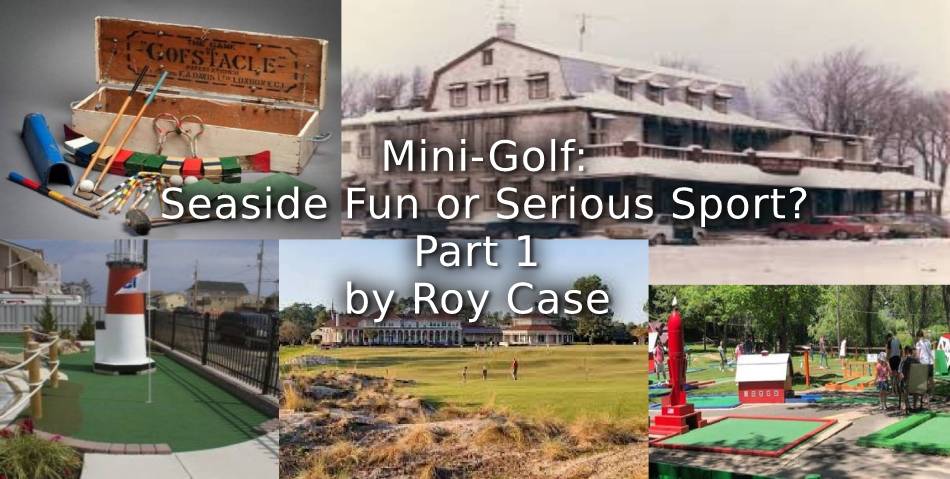

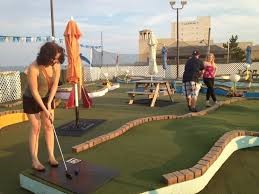

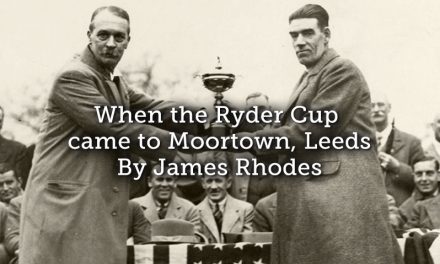


Hi Roy,
mini-golf and gender in Victorian Britain
Fascinating material on ‘mini-golf’, often called ‘miniature golf’ in America around 1930. There’s always debate about the origins of these games and I don’t know enough to enter it. When I was researching my book on THE VICTORIANS AND SPORT I came across a flurry of material on ‘miniature golf’ played on grass, converted tennis or croquet lawns in the 1890a, It seems to have had particular appeal to women. At least it was certainly mentioned in media produced for women. Gentlewoman, 8 July 1893 describes a croquet lawn converted into ‘a miniature golf links’, marked out with bunkers. It refers to an article in Golf the previous week giving the rules for this ‘new and amusing game’. Around the same time there was a game called ‘put-put’ which seems to be related.
Queen 14 September 1895 introduces ethnicity too, and described miniature golf as ‘a new importation, it being introduced by certain Anglo-Indians, and it is only here and there that it is played at present, although it is likely to soon become generally adopted. It resembles golf proper, only that the holes are smaller, and the word “links” can hardly be applied to the limited space at command’
he Victorians and Sport